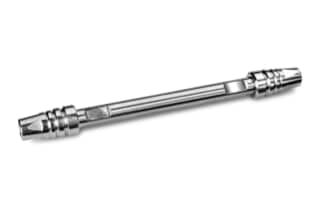
|
Chemistry |
PFP/Fluoro-Phenyl |
|
Separation Mode |
SuperCritical Fluid (SFC) |
|
Particle Substrate |
Hybrid |
|
Maximum Pressure |
6000 psi (415 Bar) |
|
Endcapped |
No |
|
Bonding Technology |
Fluoro-Phenyl |
|
Silanol Activity |
Medium |
|
Particle Shape |
Spherical |
|
Particle Size |
1.7 µm |
|
Endfitting Type |
Parker-style |
|
Pore Size |
130 Å |
|
Format |
Column |
|
Surface Area |
185 |
|
System |
UPC2, SFC |
|
Particle Technology |
CSH |
|
Technique |
SFC, SFC/MS |
|
Inner Diameter |
3 mm |
|
Length |
150 mm |
|
Carbon Load |
10 % |
|
eCord |
Yes |
|
UNSPSC |
41115711 |
|
Brand |
Viridis |
|
Product Type |
Columns |
|
Units per Package |
1 pk |

Viridis CSH Fluoro-Phenyl Column, 130Å, 1.7 µm, 3 mm X 150 mm, 1/pk
The Viridis Columns are built with a very low metal content and strict product criteria, which are based on Waters' extensive experience manufacturing chromatographic equipment. They are designed to be exceptionally reproducible and predictable. They are available in analytical screening dimensions as well as preparative column dimensions for purification. Separation techniques can be enhanced and scaled up to Viridis OBD preparation columns.
Viridis' sub-2-µm and 3.5-µm columns, which were created and tested for the ACQUITY UPC2 system, exhibit outstanding effectiveness and resolution. Even for well-retained basic achiral compounds, the decrease and control of surface silanol activity on Viridis particles produces good peak morphologies under SFC conditions without the addition of mobile-phase additives.
With strong retention, peak shape, and selectivity characteristics both with and without additives, it is widely used in achiral SFC separations. If you choose our tools, software, chemistries, and services, you have all you need to succeed in any analysis. Only Waters Quality Parts are compatible with your Waters instruments because they have been tried and trued for continuous optimal performance of your Waters systems. When you use Waters Quality Parts, you can rely on consistent instrument performance, accurate and repeatable results, and maintained system compliance.
You can shop for lab equipment from our website or by browsing through our brochure, and get in touch with us if you have any questions or need recommendations for product selection. The Waters Carbamate Analysis Kit, which includes a Waters Carbamate column, Oasis HLB cartridges, vials, and Reference Standards, is an additional choice that may be of interest to you. These EPA Method 531.2-compliant solutions make your analysis easier while boosting your confidence in the outcomes. The primary column for EPA Method 531.2 is the carbamate column, which was created and evaluated for high sensitivity and exceptional resolution; Oasis HLB Cartridges are used for sample preparation and concentration to ensure maximum sensitivity; To ensure the best possible analysis, vials must be clean and free of background contamination; Carbamate Reference Standards - These reference materials advance your level of understanding for both drinking water and wastewater.
How Does One Define Elution In Chromatography?
Elution, or the separation of an antibody from the antigen to which it is bound, is a chromatographic procedure that involves employing a solvent to remove an adsorbed material from a solid adsorbing media. Eluent or eluant is the "carrier" component of the mobile phase used in the procedure, moving the analytes through the chromatograph.